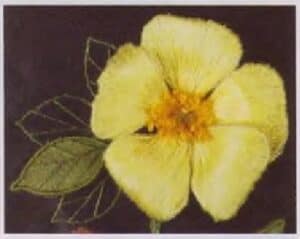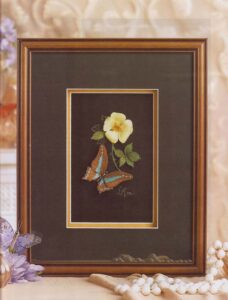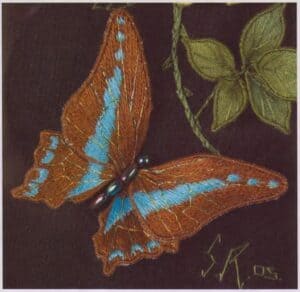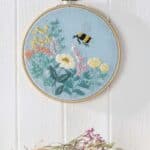Butterfly with a rose-embroidery design
This exquisite butterfly is just about to visit a bright, fully open rose. Suzanne Richards embroidered this charming stump work, and captured an exquisite moment in time.
MATERIALS
• 23cm x 28cm (9 in x 11 in ) rectangle o f black duchess satin
• 40cm (16in) square o f white organza
20cm (8in) square o f green organza
• 25cm (¼yd) of calico
• DMC Stranded Embroidery Cotton: 1 skein each of dark lemon (445), dark blue green (501), dark moss green (580), light tangerine (742), dark golden brown (975), light bright turquoise (3846)
• Kreinik Blending Filament Metallics: 1 spool o f royal blue (033)
• Iridescent beads: 2mm round; 3, 5mm bugle
• No 8 crewel needle
• 2 darning needles
• Fine beading wire
• Cake wire
• Tracing paper
• Dressmaker’s carbon paper
• Pencil
• 17.5 cm x 22.5 cm (7 in x 9 in) wooden frame Staples or thumb tacks
• Small embroidery hoop
STITCHES USED
Backstitch, fly stitch, stab stitch, long and short stitch, straight stitch, whipped chain stitch
PREPARATION
Cut two 20cm squares of white organza, lay them so the grain is in opposite directions, put them in the
hoop and tension them unitl they’re drum-tight. Trim the surplus fabric. Trace the petals, leaves and butterfly wings from the pattern sheet onto tracing paper following the numbers indicated, then cut them out.
Trace the design, then transfer the stems and shadow leaves onto the black duchess satin with the
dressmaker’s carbon paper.
CUTTING
From the calico, cut: – one 20cm square – one 23cm x 28cm rectangle.
EMBROIDERY
Flower: Pin the petal pattern on the white organza, bend the cake wire around the edge leaving 2cm tails
and tack it in place with the stitches 5mm apart with one strand of dark lemon (445), in the No 8 crewel
needle and. Take off the tracing, then overcast the wire with stab stitch to hold it firmly in place.
Mark pencil lines following the curve of the petals, then fill in with long and short stitch and the same
thread, taking the needle down at the bottom of the petal and out at the top incorporating a few of the stab stitches to hold it in place. Make five petals.
Tip: Put most of the stitches halfway down the petal to save creating bulk at the bottom.
Leaves: Tension the green organza in the hoop, then bend the cake wire around the tracing paper leaf shape
leaving tails as before, and stabstitch it in place with dark moss green (580). Create the veins with
one strand of dark blue green (501) and fly-stitch. Make six leaves.
Butterfly: Tension the calico in the hoop as before, then bend the cake wire around the tracing paper wing
shapes and stab-stitch it in place with dark golden brown (975).
Mark out six angled straight stitches to show direction, then fill the wings with long and short stitches, passing the needle down at the base and coming up just inside the stab-stitched edge. Avoid creating bulk at the bottom of the wings. Overstitch the blue patches with one strand of light bright turquoise (3846), using the
photograph and pattern as a guide for placement. Work fly-stitch over the wings with royal blue (033)
Blending Filament.
ASSEMBLY
Lay the 23cm x 28cm calico rectangle on a firm surface with the black duchess satin over it, then put
them on the frame. Make it drum-tight by attaching it to the frame with staples or thumb tacks.
Work the stem of the rose with whipped chain stitch and two strands of dark blue green (501), then use one strand to backstitch the leaf stem and the outline of the shadow leaves. Work their veins and the thorns on the rose stem with straight stitch.
Cut out all the prepared pieces then put them in place on the black duchess satin. Hold a petal in place
with a darning needle. Pass the other darning needle through the fabric until the eye is halfway through,
creating a hole. Thread the wire tails through the hole and remove the needle. Fold the wires against the
back of the fabric and secure them with a few stitches. Do the same for all the detached elements.
Butterfly: Attach the round iridescent bead for the head and the bugle beads for the butterfly’s body with
the beading wire.

Stamens: Thread two strands of light tangerine (742) in the crewel needle. Pass it through the fabric
at the base of the rose petal leaving a tail. Tie a knot in the tail and pull the thread through stopping so the knot is 2mm from the petal.
Take a couple of backstitches on the wrong side of the fabric, then pass the needle back to the front, next to the first stitch. Make a knot in the thread 2mm from the petal and cut the thread. Repeat this process around the bottom of the petals leaving a hole in the centre,
Your stumpwork is now ready for framing.











